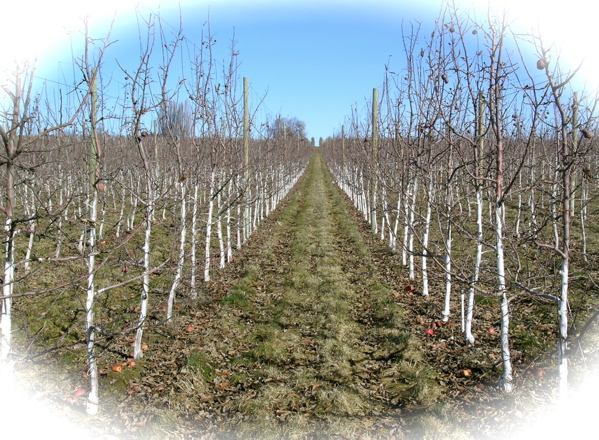Apple Scion/Rootstock Selection and Planning for Michigan
R.L. Perry and J. Hull
Dept. of Horticulture
Michigan State University
East Lansing, MI 48824
J. M. Clements
Extension Tree Fruit Specialist
University of Massachusetts Amherst
Amherst, MA 01003
|
 |
Updated January 2008
INTRODUCTION
The training system that an apple (Malus x domestica)
grower selects must be one which best maximizes all the resources in making
the enterprise a profitable venture. There are many parts to the orchard system
decision "puzzle" which
must fit together in a complementary arrangement to gain maximum precision
and profitability. The most immediate question that must be answered regarding
the establishment of a new orchard is spacing. Extension agents and growers
often need assistance in determining optimum tree density for sites. Trees
planted too close, cause excessive shading and competition for resources results
in inadequate light penetration, poor quality fruit, low cropping, excessive
labor in pruning to reduce shading impact, etc. Excessive distance results
in inefficient planting designs where the land surface is under utilized. In
1989, we made an initial attempt at trying to simplify the decision making
process by considering the most important variables and assigning them values
(number codes in parentheses) in a formula. Assessments on vigor are derived
from rootstock and cultivar trials and field observations. Our experience gained
from working with the high density orchards and with new cultivars and rootstocks
has encouraged us to frequently update the model. The formula is available
on the Michigan State University Department of Horticulture web site for general
use by the public, students and extension field agents in an interactive mode
(spacing calculator) http://www.hrt.msu.edu/department/Perry/Spacing_Fruit/mispacingPC.htm,
and below. Still more revision in the future will be necessary as we learn
more of the technical intricacies of new rootstocks, cultivars, marketing demands
and management constraints.
The primary factors affecting spacing include; scion
vigor, rootstock vigor, soil type, irrigation, management system and the interactions
that take place between them. This spacing recommendation is only relevant
to Michigan sites and for single row arrangement of trees -- use good judjment
when applying to other situations. Use
the on-line form below (enter values) to calculate in-row tree spacing based
on your input:
For the iPhone/Safari Mobile (or simplified version) of this
calculator,
click here.
The formula and calculation:
In-row tree spacing.
Scion (C) + Rootstock (R) + Soil (S) + Irrigation (I) + Management System
(M)
(where high density systems are applied, multiply sum by factors noted in Management
category)
Row spacing width.
North/south direction; 1.3 times expected or projected tree
height. (For East/West row direction, use 1.5.) Tall Spindle limited to
10 ft. height.
Example calculations:
Example 1: Idared / M.26, sandy (droughty) soil, drip
irrigated, on stakes, expect 12 ft. high tree:
In-row tree spacing = (2 + 2.5 + 1 + 2 + 0) = 7.5 feet
Row spacing = 1.3 x 12 = 15.6 feet
Recommended tree spacing =
7.5 x15.6 ft
Trees per acre = 372
Example 2: McIntosh / MM.106, sandy soil, no irrigation, low intensity, expect
14 ft. high tree:
In-row tree spacing = (4 + 7 + 0 + 0 + 3) = 14 feet
Row spacing = 1.3 x 14 = 18.2 feet
Recommended tree spacing = 14 x18.2 ft
Trees per acre = 171
Ex. 3: Jonagold / M.9 EMLA, fair vigor soil, drip irrigated, Vertical Axis,
expect 10 ft. high tree:
In-row tree spacing = (3 + 1 + 2 + 2 + 0) * 0.7 = 5.6 feet
Row spacing = 1.3 x 10 = 13 feet
Recommended tree spacing = 5.6 x13 ft
Trees per acre = 598
Ex. 4: Empire / Mark, vigorous clay loam soil, drip irrig., slender spindle, expect 8
ft. high tree:
In-row tree spacing = (2 + 0.5 + 3 + 2 + 0 ) * 0.6 = 4.5 feet
Row spacing = 1.3 x 8 = 10.4 feet
Recommended tree spacing = 4.5 x 10.4 ft
Trees per acre = 931
References
For a complete list of references, see the complete publication Apple
Scion and Rootstock Selection and Planning for Michigan.
Copyright©2008 Jon Clements and Ron Perry
